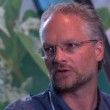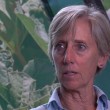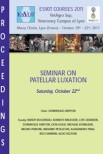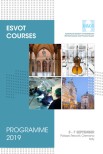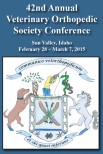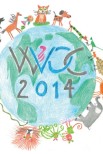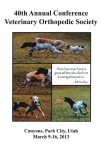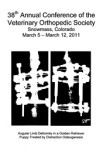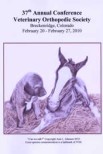
Donald L Piermattei DVM, PhD
Diplomate, American College of Veterinary Surgeons
Professor Emeritus, Colorado State University
G.S-S. What stimulated you to specialise in Veterinary Orthopaedics and where were you at that time?
D.L.P. Wade Brinker was my mentor and my inspiration. After graduation and two years in the U.S. Army Veterinary Corps I returned to Michigan State University as an instructor in the small animal clinic. Today the position would be as an intern. Wade was of course the chief surgeon and later department head. Although I was initially attached to the medicine service, I spent any spare time watching Wade operate. After two years I was able to move to the surgical service and to work with Wade full-time. By necessity he was a general surgeon and so was I, although my chief interest was in orthopaedics, until the early 80’s. At that time I was chief of surgery at Colorado State University where we had two general surgical services. Some of the surgeons were becoming increasingly uncomfortable with orthopaedics, so we split into a general and an ortho service, and I went full time ortho. It’s interesting to note that, until the seventies, the surgical case load at most university clinics was dominated by orthopaedic cases. Not until the medical services became highly trained did the referral of soft tissue cases increase both from within the clinic and from referring veterinarians.
G.S-S. The story of your ‘An Atlas of Surgical Approaches to the Bones of the Dog and Cat” – is a story in itself; one of the most successful small animal texts that has ever been published. Please enlarge upon that story?
D.L.P The Atlas was first published in 1966. It was conceived and written while I was on the staff of Texas A&M University. The first year I was there, 1962, I was the small animal surgeon, so I was on my own. This followed two years in private practice after leaving Michigan State. As I began teaching in the operative practice laboratory, I found myself wishing for an illustrated guide to surgical approaches. As a student of Brinker’s I was very much committed to internal fixation of fractures. The only published material on approaches was Brinker’s in ‘Canine Surgery’, but they were photographs and I thought that illustrations were much clearer for the beginner. I found the format that I envisioned in a human text by Banks and Laufman. I needed an artist and one was available in the Anatomy Department. Dr. Roger Greeley had produced a number of illustrated teaching aids for his anatomy classes. He was self-taught but very talented and of course had the anatomy ‘down cold’. At that time there were only three publishers in the veterinary market and I approached W.B. Saunders Company because I liked the quality of their only other veterinary text. They sent their staff artist to give Dr. Greeley some advice, and we were off, and with regard to publishing we were just two neophytes. Now in its’ 4th edition, with the addition of Dr. Ken Johnson as co-author, It has sold well and been translated into several languages. I have been pleased that it accomplished its’ objective of providing direction for atraumatic surgical exposures to the bones and joints. I have received many comments about it, the most amusing being ‘why don’t you show both left and right?’, and ‘why don’t you make it autoclavable?’
G.S-S, Apart from the above book, what particular surgical techniques or reports, which you published, do you find the most satisfying?
D.L.P. At the time that I returned from practice to academia (Colorado State University) in 1980, I began to think about the need for a practical book that covered all aspects of clinical orthopaedics, one that could be used by students and practitioners. At that time most general small animal practices were still doing most of their own surgeries, as referral centres were not widespread. I broached the idea to Wade Brinker because I wanted to see his extensive lecture notes on fracture treatment widely published. He recruited Gretchen Flo, a colleague from Michigan State University, and we created the ‘Handbook of Small Animal Orthopedics and Fracture Treatment’, which was published in 1983. Brinker did the fractures, I was editor and wrote the lameness and joint surgery sections, and Flo took care of musculoskeletal diseases. That book was very well received and is now in the 4th edition, with the 5th in progress. Brinker dropped out for the 3rd edition, at which point I took over the fractures and Flo the lameness and joint disease. Charlie DeCamp joined us for the 4th edition and will take over for the 5th as both Flo and I have retired.
G.S-S. With regard to operating techniques did you have some ideas that you published, which have now become part of the ‘lexicon’ of veterinary orthopaedics?
D.L.P.I developed some of the approaches shown in the early editions of the Atlas although I did not put my name on them. I particularly remember working out the craniolateral approach to the shoulder joint by osteotomy of the acromion process. I developed some techniques for fracture fixation and arthrodesis in the Greyhound only to later find that Jon Dee was doing the identical things. Shows how if you work at a problem from basic principles (in this case AO techniques) you will all arrive at the same place. I guess I was more of a modifier of techniques than an originator. I had my own methods for extracapsular, fascial graft, and fibular transposition cruciate stabilization. These were all published in the Handbook rather than in journal publications so they were not extensively referenced. Perhaps my most notable original contribution came not in orthopaedics but in urologic surgery. When I was an intern at Michigan State I improvised the technique of retrograde urohydropulsion for returning urethral uroliths to the bladder in the male dog. I thought nothing of it for 17 years. When I was on the staff at University of Minnesota I happened to perform the procedure for Carl Osborne, the noted urologist. He went ballistic, comparing the technique comparable to the advent of sliced bread. He insisted I publish it, which I did with his help in 1974 in Current Therapy V. In 1995 I was in England at an AO course and during the course of an evening social event I met a veterinarian who was someone’s companion and not a course participant. When I introduced myself, he exclaimed ‘You’re the chap that showed us how to get stones out of the urethra!’ Sic transit Gloria as far as my orthopaedic reputation with medical types.
G.S-S. In a recent email you wrote that you have now moved away from veterinary surgery and are currently building your third personal plane yourself. Please recount for readers some more about this venture. Is another ‘Red Baron’ is likely to appear from a valley in the Rockies?
D.L.P. When I retired from Colorado State University in 1992 I started a private surgical practice of two days a week. We owned an airplane at the time and I was concerned that the income would no longer support it, so I decided to build an airplane from a kit. Doing so gives you the authority to maintain it without the need for certified mechanics. I had become involved in the maintenance of the previous airplane so had acquired basic building skills to work on an all aluminium riveted airplane. Fourteen thousand rivets and four years later I had an airplane. I enjoyed the building so the first was sold and a second and then a third was built. I am just starting to fly the third and it will be my last. I will keep it here at my place and fly it from our 40 acre pasture, so my expenses will be minimal. It is a low and slow airplane, more for puttering around in, we call it ‘converting gasoline into noise’, than travelling.



